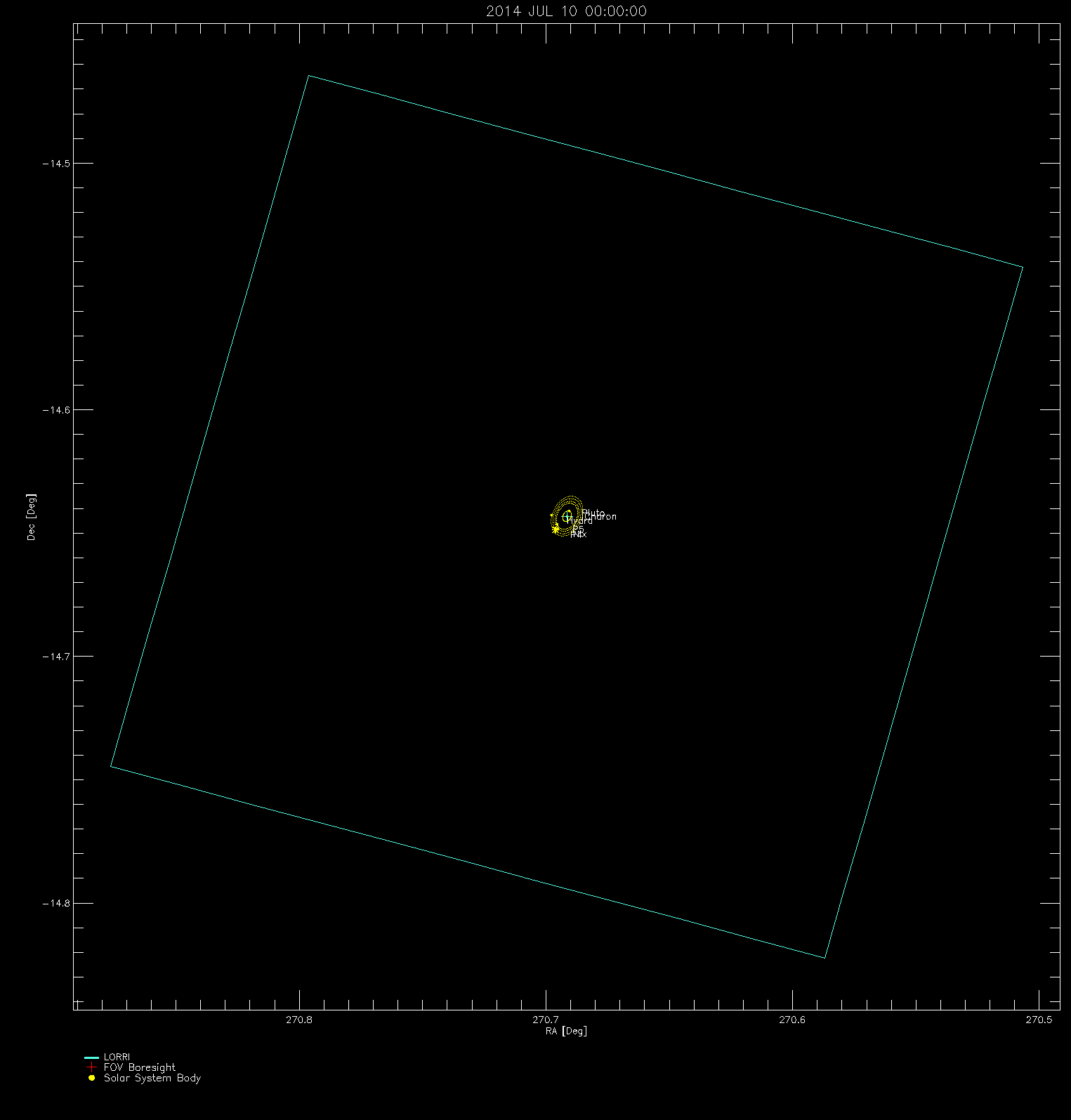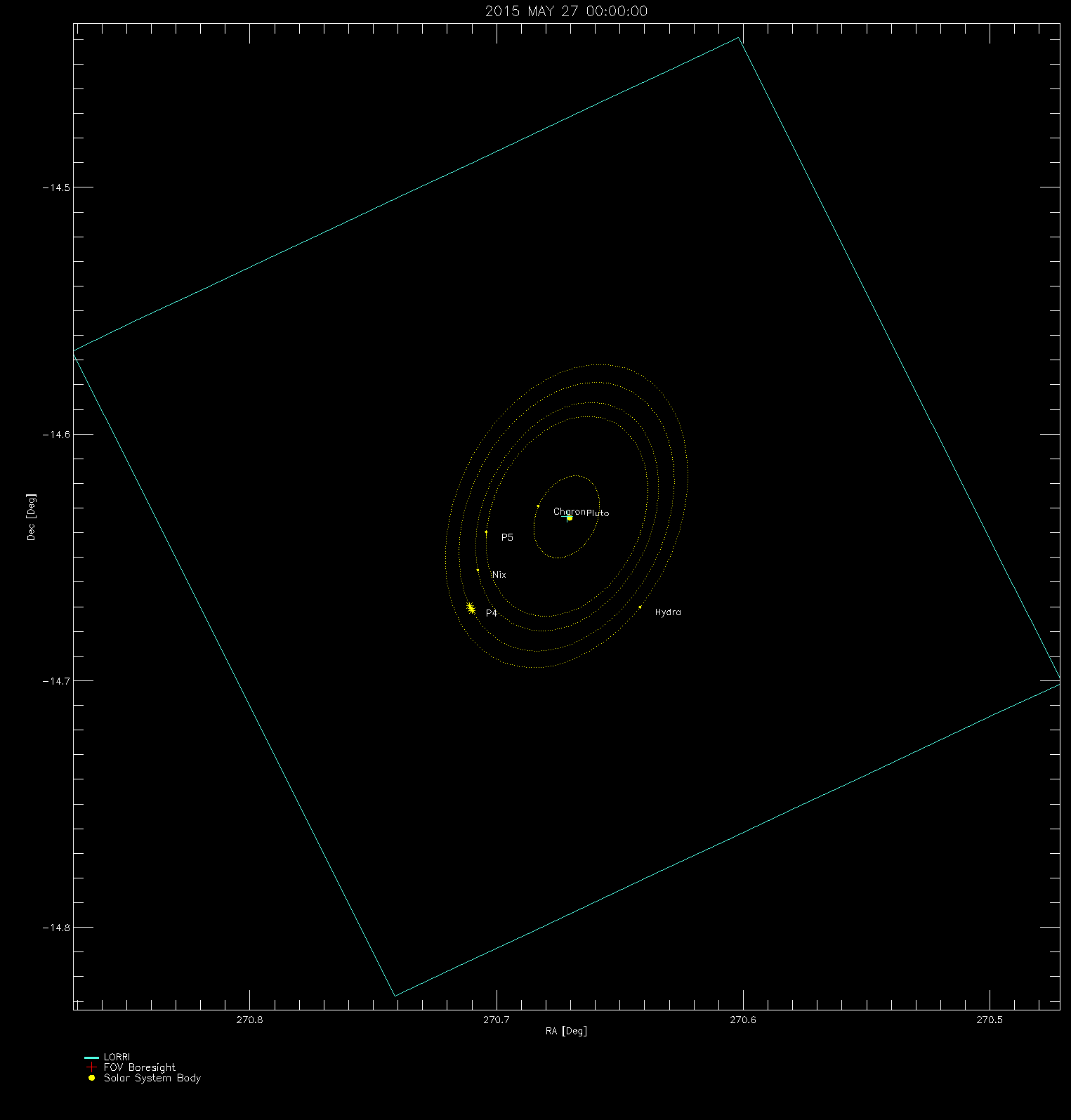Emily Lakdawalla • Jul 18, 2014
New Horizons to take new photos of Pluto and Charon, beginning optical navigation campaign
New Horizons' scientific mission at Pluto doesn't technically begin until the end of this year, but starting in two days, the spacecraft will begin to take a lot of photos of Pluto and Charon. Why would they be doing this, if not for science? What's the point of taking pictures in which Pluto and Charon will be teeny weeny dots, barely distinguishable from stars? The answer: they're taking the photos in order to figure out how to steer the spacecraft.
Nearly every deep-space mission uses optical navigation methods to help navigators back on Earth fine-tune their path to the target. We know very well from two-way radio communication the position of spacecraft with respect to Earth. What's less precise is our knowledge of the position of the places we're aiming for. This is particularly true of small or distant targets like asteroids and Kuiper belt objects. You need big telescopes to see them, so we have relatively few measurements of their positions with respect to the stars, and few measurements lead to relatively big error bars on our predictions of their future positions.
The cameras on spacecraft never have the resolving power of our better Earth-based telescopes, so at first we steer spacecraft according to what we've been able to determine from Earth. But at some point on every space mission, a spacecraft approaches close enough to its target that its relatively small camera can do better than the bigger 'scopes back at home.
It's going to be at least February 2015 before New Horizons' highest-resolution camera, the Long Range Reconnaissance Imager (LORRI), will be able to get more detailed photos of Pluto and Charon than Hubble can. But LORRI is already capable of taking optical navigation images that will help us fix Pluto's position with more certainty than we could achieve with Earth-based observations alone. That effort begins in earnest with the first optical navigation campaign on July 20, and includes three more campaigns in 2015. The effort is summarized in this 2012 paper by William Owen, Philip Dumont, and Coralie Jackman.
Here's a summary of the campaigns from that paper. They will perform two kinds of observations with LORRI. In full-resolution observations, they return the photos as they are taken by the camera. But they can't shoot very long exposures in this mode, because the images smear as the spacecraft's pointing drifts. They can also use LORRI in a quarter-resolution mode in which they bin 4x4 arrays of pixels together on the camera chip; in this mode they can take much longer exposures. It's somewhat counterintuitive, but the fainter small moons like Nix and Hydra will be visible first in the lower-resolution binned LORRI images before they are visible in the full-resolution images; New Horizons will first detect them in January during the second optical navigation campaign. In the third and fourth campaigns, they use another instrument, the Multi-spectral Visual Imaging Camera (MVIC), as a backup to LORRI, in case the LORRI observations fail to execute for some reason. MVIC has a resolution 5 times lower than LORRI.
| Campaign | Dates M/D/Y | Days from Pluto | LORRI 1x1 | LORRI 4x4 | MVIC Pan |
|---|---|---|---|---|---|
| 1 | 7/20/14 - 7/27/14 | −359 to −352 | 5 images/ 12 hours | None | None |
| 2 | 1/25/15 - 2/1/15 | −170 to −163 | 5 images/ 12 hours | 5 images/ 48 hours | None |
| 2/1/15 - 3/6/15 | −163 to −130 | None | 5 images/ 48 hours | None | |
| 3 | 4/5/15 - 4/15/15 | −100 to −90 | None | 5 images/ 48 hours | None |
| 4/15/15 - 4/22/15 | −90 to −83 | 4 images/ 12 hours | 5 images/ 48 hours | 2 images/ 24 hours | |
| 4/22/15 - 5/14/15 | −82 to −60 | None | 5 images/ 48 hours | None | |
| 4 | 5/28/15 - 6/23/15 | −47 to −21 | 4 images/ 24 hours | 6 images/ 24 hours | 2 images/ 24 hours |
| 6/23/15 - 7/16/15 | −21 to +1 | 5 images/ 24 hours | None | None |
Here's a little more detail on what to expect from the optical navigation observations in each campaign.
Campaign 1: July 20 through 27, 2014
- Two observations per day over eight days
- Each observation includes five full-resolution LORRI images
- Will capture one full revolution of Charon around Pluto
- Smaller moons will likely not be visible
- Charon will only be separated from Pluto by a few LORRI pixels.
Here is a simulation of the field of view of the LORRI camera on the Pluto system at this moment, using the New Horizons GeoViz tool. The blue square is the LORRI field of view, and I've sized the plot such that the LORRI field of view is 1024 pixels square, as it should be (if you click through to get to its full resolution). If you want to make plots like this, ask GeoViz for plots that have a 0.2-degree radius and a plot size of 1525 pixels. The timing of the observations is not the same as the actual ones will be -- I don't know the times that specifically -- but the cadence is correct, one frame every 12 hours. The whole Pluto system, out to Hydra, fits in a box just 60 pixels tall. (Hydra will probably not be visible at this range.)
Campaign 2: January 25 through March 6, 2015
- One observation every other day for six weeks
- Each observation includes five quarter-resolution LORRI images
- Will capture one full revolution of Hydra around Pluto
- Additionally, during the first week (January 25-February 1), there will be another Charon revolution campaign like Campaign 1, in which Pluto will be barely resolved
Here's a simulation of the first week of full-resolution LORRI frames covering a Charon revolution -- as before, they are at the right cadence though not necessarily the right times, one frame every 12 hours. Even though it will have been six months since the previous images, the system hardly appears any bigger!
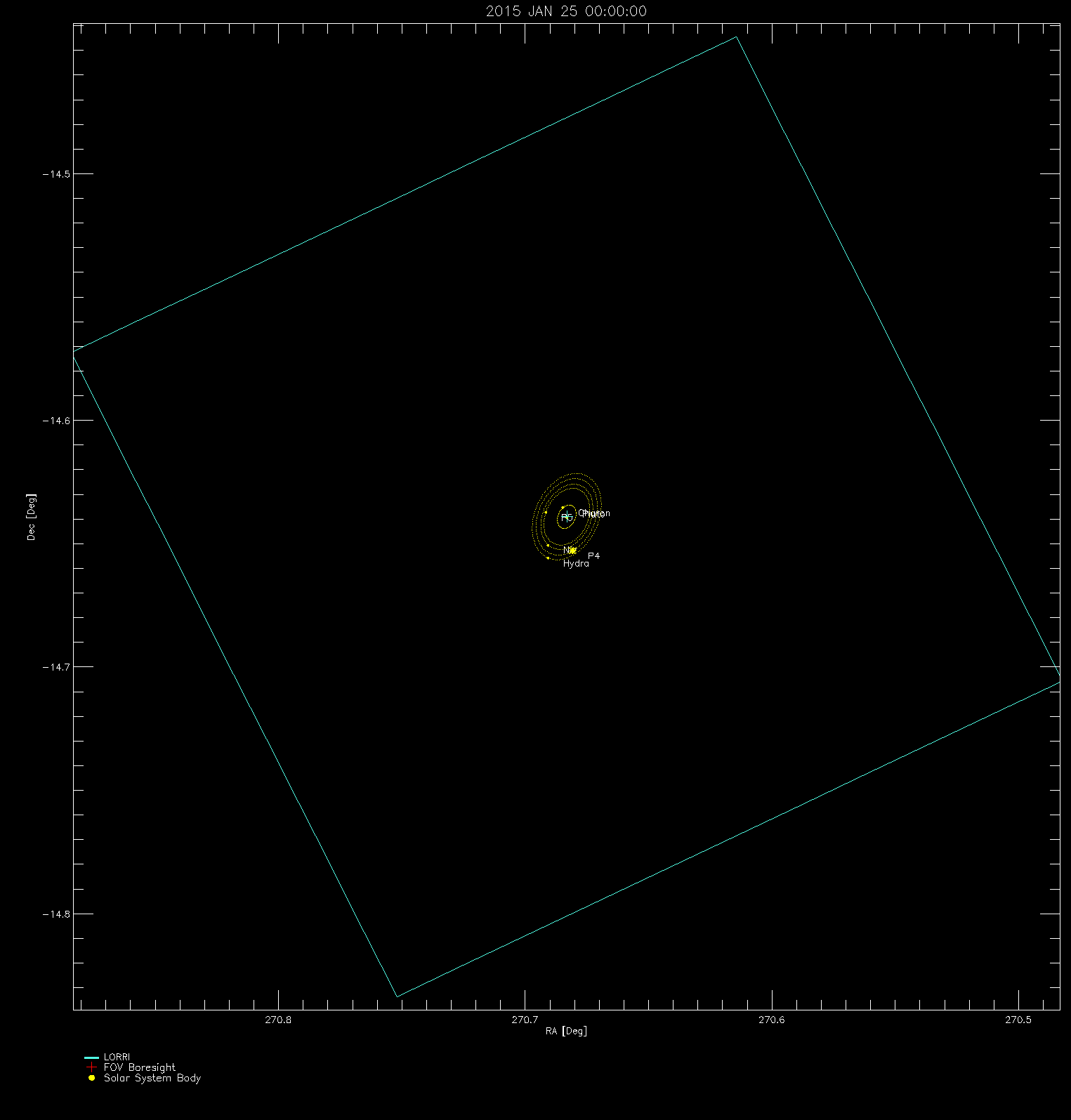
And here's a simulation of the full campaign of quarter-resolution LORRI frames covering a Hydra revolution, one frame every 48 hours. These frames will only be 256 pixels square. If you want to make plots like this, ask GeoViz for plots with a 0.21-degree radius and a plot size of 487 pixels.
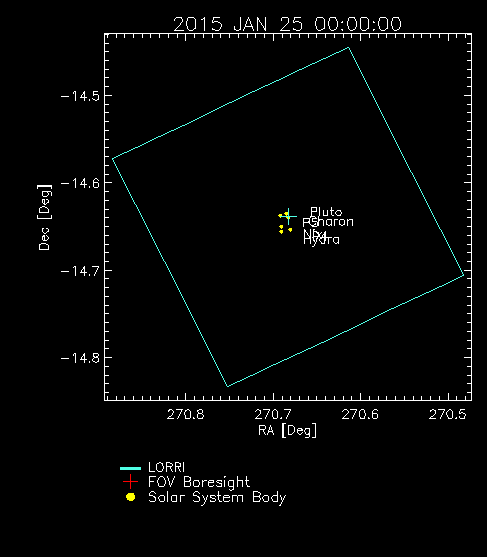
Campaign 3: April 5 through May 15, 2015
- Much like Campaign 2 (quarter-res observations every other day for 6 weeks, one Hydra orbit)
- For the week of April 15 to 22, another Charon revolution campaign like Campaign 1; Pluto will be roughly 5 pixels across
- But instead of 5 LORRI images every 12 hours, there are 4 LORRI images plus one MVIC image as a backup
A simulation of the Charon campaign:
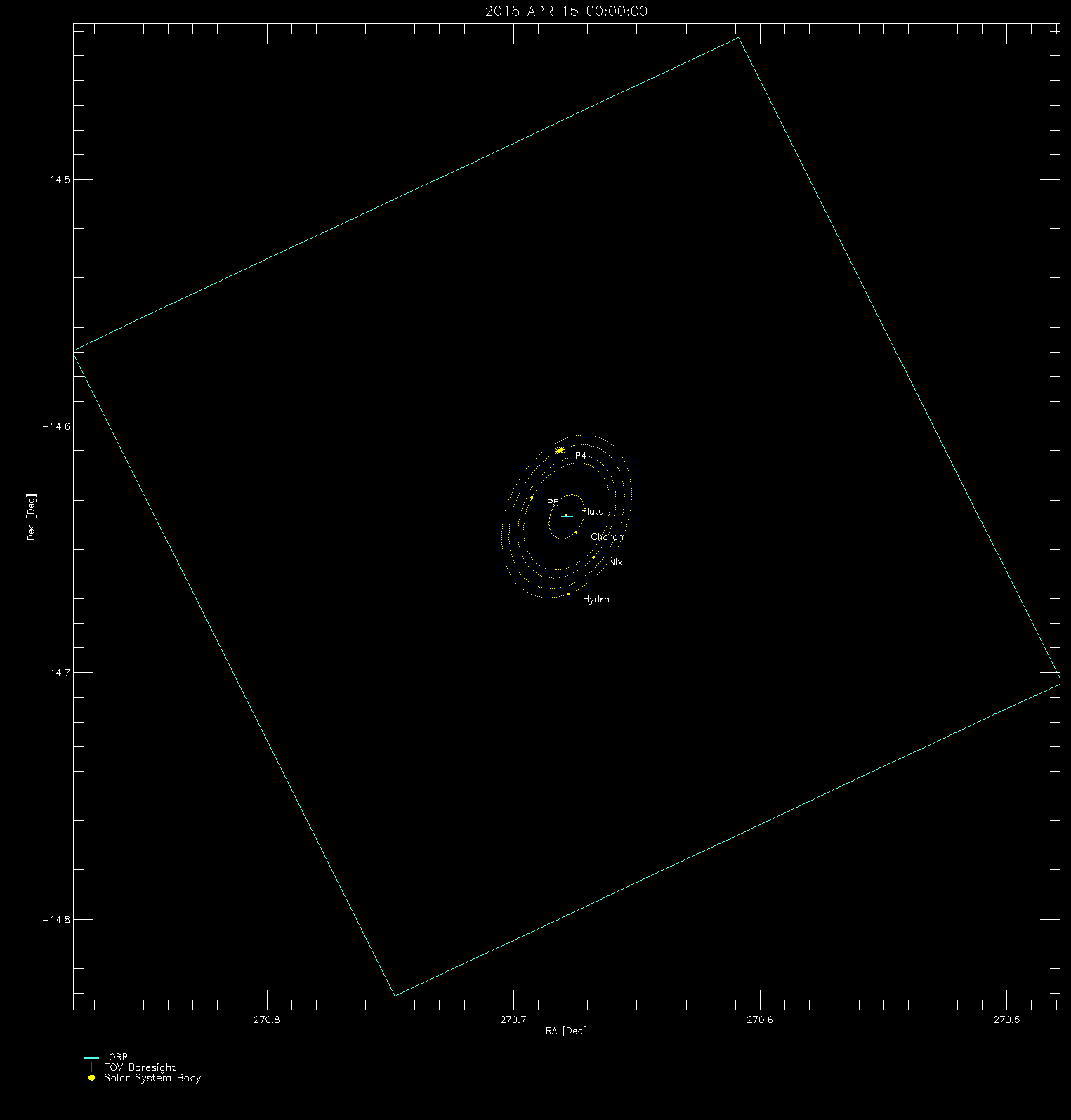
And a simulation of the Hydra campaign -- these will all just be moving dots, but it's exciting to see the sizes of the orbits visibly grow over these six weeks:
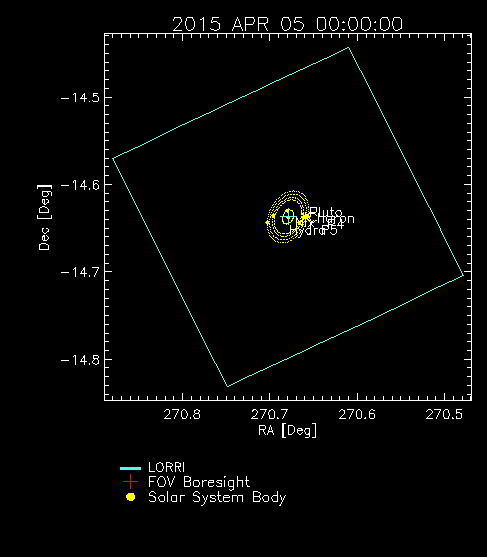
From May 16 to May 27, New Horizons will cease observing Pluto, turning to Earth in a spin-stabilized mode to completely empty its data recorders in preparation for the flyby.
Campaign 4: May 27 through July 16, 2015
- Once-daily observations for about seven weeks
- For the first 26 days (up to 21 days before closest approach), each observation includes 4 full-resolution LORRI, 6 quarter-resolution LORRI, and 2 MVIC images.
- For the final 23 days (from 21 days before to 1 day after closest approach), each observation includes 5 full-resolution LORRI images.
Here is a simulation of the full-resolution LORRI observations over those seven weeks. Zoom! As with the previous animations, I've targeted GeoViz at the Pluto-Charon barycenter -- the point in space, outside Pluto's surface, around which both bodies orbit -- and New Horizons is now close enough that you can really see Pluto gyrating around. This animation is definitely not a perfect representation of the images LORRI will take; the actual images will be taken at different times, and I suspect that they will be targeted more precisely to make sure that as many as possible of the things in the Pluto system are within the field of view. But it gives you a schematic sense of how the optical navigation campaign will play out through the encounter. And also shows you just how close New Horizons has to get before Pluto gets really big in the field of view! It's going to be a long, impatient wait for the images that we really want to see, showing detailed geology on the surfaces of Pluto and Charon -- the really great stuff doesn't happen until July, just days before closest approach.
The process of how the optical navigation team will turn these images into data on the positions of Pluto and its moons is fascinating, incorporating lots of very tricky work; for instance, the team figured out the geometric distortion of the cameras by performing in-flight observations of star clusters M6 and M7. (They call the distortion "significant", a "pincushion distortion...amounting to 1.73 +/- 0.01 pixels in the corners of the field.") There are actually two independent optical navigation teams, one at KinetX, Inc. and one at the Jet Propulsion Laboratory, each of which has developed their own software (KinetX using MATLAB, JPL using Fortran and C), to keep each other honest. It's all very well-explained in the Owen, Dumont, and Jackman article.
But of course the reason I'm really interested in these photos is because each set of optical navigation images will be the best-yet images that New Horizons has taken of Pluto. Because they're critical for navigation, they have high downlink priority, so even while New Horizons is doing science these will be returned rapidly from the spacecraft, each one our best view and a fresh thrill -- despite the fact that they'll be lacking in much surface detail until July.
The mission will be sharing the pictures with us as they arrive on Earth. I'm not sure how fast next week's optical navigation photos will appear on the New Horizons website, because they don't have an automated process in place yet; it will take them some manual work, and that will take a little time. But with the mission's firm commitment to openness and public outreach I know we'll see them quite soon!
Support our core enterprises
Your support powers our mission to explore worlds, find life, and defend Earth. You make all the difference when you make a gift. Give today!
Donate

 Explore Worlds
Explore Worlds Find Life
Find Life Defend Earth
Defend Earth


